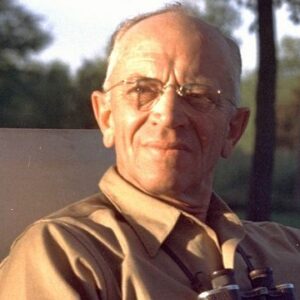Aldo Leopold was a famous American forester, ecologist, environmentalist, scientist, and author. He taught at the University of Wisconsin and also wrote a book called “A Sand County Almanac.” With this book, he shared his ideas about “land ethic,” which are new ways of thinking about how to protect the land. Aldo was the first person to use the word “wilderness” to talk about how to protect wildlife. He was very important to the making of the Gila Wilderness, which was the first national wilderness area in the Forest Service system. He was one of the people who started the Wildlife Society and the Wilderness Society. He had a lot of knowledge about how to manage wildlife, so he pushed for both public and private landowners to manage wildlife habitats in a scientific way. In his book “Game Management,” he talked about how to take care of and bring back wildlife populations. Aside from that, he wrote more than 300 articles, papers, and newsletters about scientific ideas. His articles on wilderness were especially well-known. The environmental movement was greatly affected by his good ideas about biodiversity and ecology. In his new “ecological ethic,” he talked about how important predators are to keeping nature in balance. It helped bears and mountain lions get back into the wild in New Mexico.
Early years and childhood
Carl Leopold and Clara Starker gave birth to Aldo Leopold in Burlington, Iowa, in the United States. May Luize, Carl Starker, and Frederic were his younger sisters and brothers.
Even though his first language was German, he learned English very quickly. He was interested in nature from a young age and learned how to hunt and work with wood from his father.
He went to Prospect Hill Elementary School first, then Burlington High School. Later, he decided to become a forester, so he went to Yale University to learn about the field.
In 1904, he went to a prep school in New Jersey called The Lawrenceville School so that he could go to Yale University. Most of the time he spent in Lawrenceville was spent watching animals.
In 1905, he went to Yale to study at the Sheffield Scientific School. The next year, he went to Yale Forest School and started taking classes. In 1909, he got his Master of Forestry.
Aldo Leopold’s Career
In 1909, he worked as an assistant forester in the Arizona Territory’s Apache National Forest.
In 1911, he was the deputy supervisor at the Carson National Forest in northern New Mexico. During his time as deputy supervisor, he took the initiative to come up with a plan for managing the Grand Canyon as a whole. He was the first person to write the Fish Handbook for the Forest Service.
In 1914, he worked in the grazing department at the U.S. Forest Service district headquarters in Albuquerque, New Mexico. The next year, he was put in charge of making plans for recreation, hunting, fishing, and public relations.
When the United States joined World War I in 1918, he quit his job as a forest ranger and became the secretary of the Albuquerque Chamber of Commerce. He went back to work for the Forest Service the next year as the assistant district forester for the Southwest forests.
He finished the “Watershed Handbook” in 1923. This book is a vivid account of what he saw in nature during his many inspection trips to forests in the Southwestern United States.
He became an associate director at the U.S. Forest Products Laboratory in Madison, Wisconsin, in 1924. He served here till 1928. Later, he did game surveys in states in the Midwest. He made survey reports about games for nine states. This used to be paid for by the Sporting Arms and Ammunition Manufacturers’ Institute.
As the head of the Game Policy Institute of the American Game Conference in 1930, he was a key figure in making the American Game Policy. In December 1930, this policy was put into place.
In 1933, he was the new chair of game management in the Department of Agricultural Economics at the University of Wisconsin. He got a Carl Schurz fellowship in 1935, and then he went to Germany to study forestry and wildlife management.
In 1936, he set up a group of experts on wildlife. The Wildlife Society is now the name of this group. In 1939, the University of Wisconsin put him in charge of a new department called the Department of Wildlife Management.
In 1943, he took the responsibility of the Wisconsin Conservation Commission for a six-year term. During his time here, he was very involved in decisions about deer, which caused a lot of trouble.
Personal History and Legacies
On October 9, 1912, he tied the knot with Estella Bergere. Starke, Luna, Nina, Carl, and Estella were their five kids.
He wrote “A Sand County Almanac,” which is about the things he saw in nature. This book came out after the author had died, in 1949. In it, he spoke out against the damage that people do to natural systems.
Estimated Net worth
Aldo is one of the wealthiest activists and is on the list of the most well-known activists. Aldo Leopold’s net worth is about $1.5 million, according to our research, Wikipedia, Forbes, and Business Insider.
Trivia
This well-known environmentalist was good at noticing things even when he was a child. He spent most of his time as a child counting and writing down information about the birds near his home.


